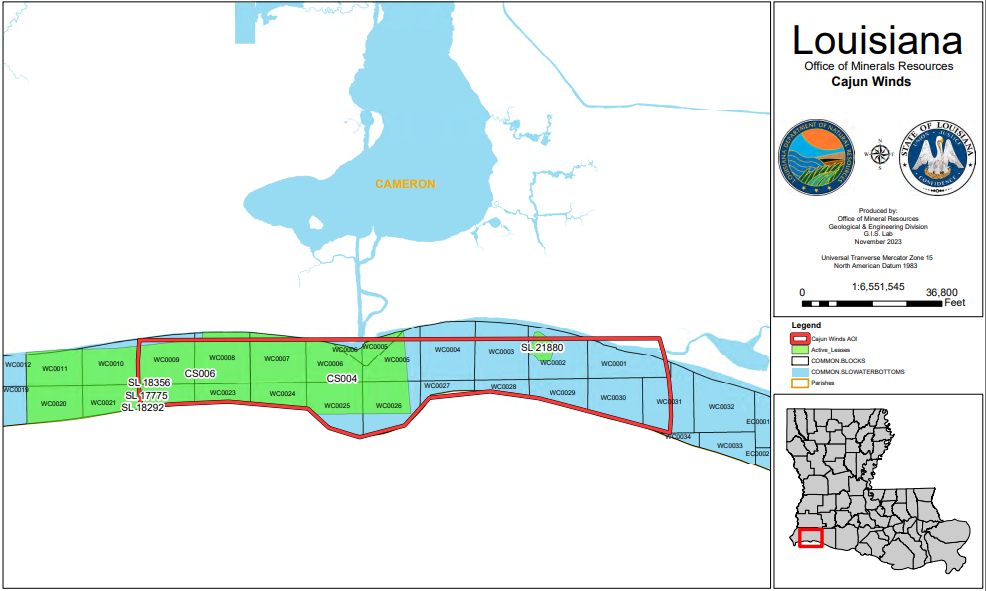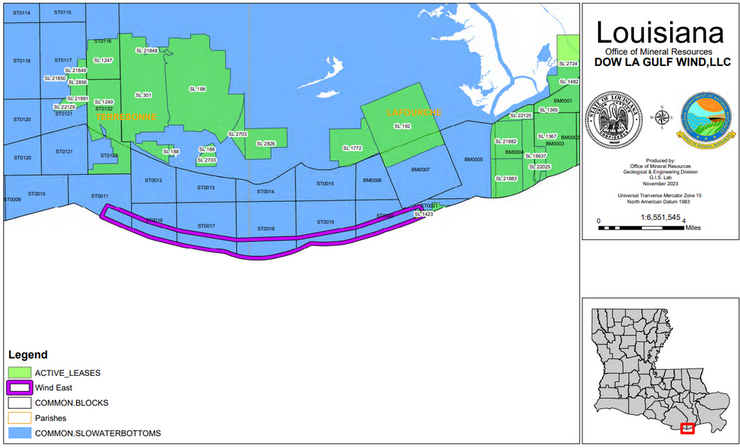Update (12/13/23): The State Mineral & Energy Board has approved both operating agreements. You can read the press release here.
Louisiana Wildlife Federation submitted comments in response to two draft operating agreements for offshore wind projects being considered in Louisiana state waters off Cameron Parish (Cajun Wind) and Terrebonne/Lafourche Parishes (Gulf Wind).
LWF attended public hearings scheduled by the Louisiana Department of Natural Resources (LDNR) in Thibodaux, Houma, and Cameron and provided some comments highlighting some of our concerns with potential impacts to wildlife (especially birds) at the hearings and submitting a formal comment letter to LDNR.


While LWF acknowledges the important role that renewable energy plays in our nation’s energy transition, it must be done responsibly in a way that avoids areas of most significant impact. LWF has serious concerns about the wildlife impacts of offshore wind projects in Louisiana nearshore waters.
Responsible offshore wind development (i) follows the mitigation hierarchy to first avoid, then minimize, mitigate, and monitor adverse impacts on marine and coastal habitats and the wildlife that rely on them, (ii) meaningfully engages state and local governments and stakeholders from the outset, (iii) uses the best available scientific and technological data to ensure science-based and stakeholder-informed decision making, and (iv) is adaptable by incorporating technological advances as they become available.
At this point in the process, comments were only sought on the draft operating agreements. Environmental impacts are not necessarily considered until later in the process as operating prepare documents to apply for a permit. LWF feels it is important to point out wildlife concerns early and often, especially considering how critical the entire Louisiana coast and nearshore waters (0-3 nautical miles from shore) is to a variety of wildlife – especially nearshore and migrating birds.
There is a significant difference in the process for considering offshore wind energy projects in state waters vs. federal waters. LDNR is leading the state waters process while the Bureau of Ocean Energy Management (BOEM) is heading the federal process. During the federal comment process for siting offshore wind in the Gulf of Mexico, in which BOEM solicited stakeholder and expert input to help inform its siting decisions, LWF joined other concerned groups cautioning against permitting offshore wind turbines within 20 nautical miles from shore. This science-based precautionary measure was recommended to protect marine mammals, neotropical migrants, coastal and marine birds, and wintering waterfowl. This recommendation was adopted by BOEM.
Nearly 30% of the birds in North America have disappeared in the last 50 years. Louisiana’s coast and nearshore waters are critically important habitat for birds, with an estimated 100 million migratory, nesting, and wintering birds relying on Louisiana’s coast annually. Louisiana hosts a significant percentage of many populations of colonial waterbird species found in the northern Gulf of Mexico, including sandwich terns (83%), Forster’s terns (71%), royal terns (51%), tricolored herons (48%), brown pelicans (47%), and black skimmers (44%), among others.
The Louisiana Department of Wildlife and Fisheries (LDWF) has raised concerns as well with the potential impact of wind projects in state waters to birds and the lack of data available to make science-based decisions. LDWF has indicated the need for more information on collision vulnerability and displacement vulnerability. Interactions of birds with wind energy infrastructure has only been looked at for larger bodied birds such as ducks and loons – and only for wind projects far offshore. Research is needed for colonial waterbirds near colony sites or for small-bodied migratory birds. Data gaps that need to be filled for proper assessment include flight altitude and migration pathways for migrant species, home range size, foraging distance, and flight behaviors for colonial waterbirds as well as identification of activity hotspots.
Other wildlife considerations highlighted included the need to study potential impacts to bats, butterflies, sea turtles, benthic habitat, and fish. Onshore wind is known to cause significant impacts to bats, however, research is needed on the potential impacts (if any) of offshore wind projects. Monarch butterflies, a candidate species under the Endangered Species Act (ESA), has an extensive migration route that includes Louisiana. Five of the world’s seven sea turtle species inhabit the Gulf of Mexico year-round, and all five of these species are protected by under the ESA (leatherbacks, loggerheads, Kemp’s ridleys, green, and hawksbill). Nearshore Louisiana waters are also home to two coastal fish species that are protected under the ESA (giant manta rays and Gulf sturgeon).
Offshore wind development in state waters is unprecedented in the United States and rare in Europe, as it often poses greater risks to wildlife and habitats, which is why LWF urges a more robust process that involves stakeholders at the outset – a key provision of “responsible development”. Much data is still needed in order to conduct proper risk assessment and site analysis to inform responsible decision-making.
LWF will continue to be engaged on this issue and highlight future opportunities for the public to offer feedback.
Read LWF’s full comments to LDNR here.
[Photo by BOEM/CC BY-SA]

